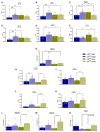Dopamine and Norepinephrine Tissue Levels in the Developing Limbic Brain Are Impacted by the Human CHRNA 6 3'-UTR Single-Nucleotide Polymorphism (rs2304297) in Rats
- PMID: 38612487
- PMCID: PMC11011259
- DOI: 10.3390/ijms25073676
Dopamine and Norepinephrine Tissue Levels in the Developing Limbic Brain Are Impacted by the Human CHRNA 6 3'-UTR Single-Nucleotide Polymorphism (rs2304297) in Rats
Abstract
We previously demonstrated that a genetic single-nucleotide polymorphism (SNP, rs2304297) in the 3' untranslated region (UTR) of the human CHRNA6 gene has sex- and genotype-dependent effects on nicotine-induced locomotion, anxiety, and nicotine + cue-induced reinstatement in adolescent rats. This study aims to investigate how the CHRNA6 3'-UTR SNP influences dopaminergic and noradrenergic tissue levels in brain reward regions during baseline and after the reinstatement of drug-seeking behavior. Naïve adolescent and adult rats, along with those undergoing nicotine + cue reinstatement and carrying the CHRNA6 3'-UTR SNP, were assessed for dopamine (DA), norepinephrine (NE), and metabolites in reward pathway regions. The results reveal age-, sex-, and genotype-dependent baseline DA, NE, and DA turnover levels. Post-reinstatement, male α6GG rats show suppressed DA levels in the Nucleus Accumbens (NAc) Shell compared to the baseline, while nicotine+ cue-induced reinstatement behavior correlates with neurotransmitter levels in specific brain regions. This study emphasizes the role of CHRNA6 3'-UTR SNP in the developmental maturation of the dopaminergic and noradrenergic system in the adolescent rat brain, with tissue levels acting as predictors of nicotine + cue-induced reinstatement.
Keywords: DA turnover; addiction; adolescence; nicotine-induced reinstatement; nucleus accumbens.
Conflict of interest statement
The authors declare no conflicts of interest.
Figures



Similar articles
-
Sub-chronic nicotine exposure influences methamphetamine self-administration and dopamine overflow in a sex-and genotype-dependent manner in humanized CHRNA6 3'-UTR SNP (rs2304297) adolescent rats.Front Pharmacol. 2024 Aug 14;15:1445303. doi: 10.3389/fphar.2024.1445303. eCollection 2024. Front Pharmacol. 2024. PMID: 39206256 Free PMC article.
-
Sex- and Genotype-Dependent Nicotine-Induced Behaviors in Adolescent Rats with a Human Polymorphism (rs2304297) in the 3'-UTR of the CHRNA6 Gene.Int J Mol Sci. 2022 Mar 15;23(6):3145. doi: 10.3390/ijms23063145. Int J Mol Sci. 2022. PMID: 35328565 Free PMC article.
-
Sex- and genotype-dependent nicotine plus cue-primed reinstatement is enhanced in adolescent Sprague Dawley rats containing the human CHRNA6 3'-UTR polymorphism (rs2304297).Front Psychiatry. 2023 Jan 10;13:1064211. doi: 10.3389/fpsyt.2022.1064211. eCollection 2022. Front Psychiatry. 2023. PMID: 36704741 Free PMC article.
-
Sex- and Genotype-Dependent Nicotine-Induced Behaviors in Adult Rats with a Human Polymorphism (rs2304297) in the 3'-UTR of the CHRNA6 Gene.Nicotine Tob Res. 2025 Jul 30:ntaf147. doi: 10.1093/ntr/ntaf147. Online ahead of print. Nicotine Tob Res. 2025. PMID: 40736212
-
The effects of acetaldehyde on nicotine-induced transmitter levels in young and adult brain areas.Brain Res Bull. 2009 Aug 14;79(6):458-62. doi: 10.1016/j.brainresbull.2009.04.005. Epub 2009 Apr 21. Brain Res Bull. 2009. PMID: 19389462
Cited by
-
Sub-chronic nicotine exposure influences methamphetamine self-administration and dopamine overflow in a sex-and genotype-dependent manner in humanized CHRNA6 3'-UTR SNP (rs2304297) adolescent rats.Front Pharmacol. 2024 Aug 14;15:1445303. doi: 10.3389/fphar.2024.1445303. eCollection 2024. Front Pharmacol. 2024. PMID: 39206256 Free PMC article.
-
Editorial: World No-Tobacco: effects of tobacco and nicotine on the brain.Front Pharmacol. 2025 May 6;16:1610178. doi: 10.3389/fphar.2025.1610178. eCollection 2025. Front Pharmacol. 2025. PMID: 40395725 Free PMC article. No abstract available.
References
-
- U.S. Department of Health and Human Services . The Health Consequences of Smoking—50 Years of Progress A Report of the Surgeon General. Centers for Disease Control and Prevention; Atlanta, GA, USA: 2014.
-
- Changeux J.-P., Bertrand D., Corringer P.-J., Dehaene S., Edelstein S., Léna C., Le Novère N., Marubio L., Picciotto M., Zoli M. Brain nicotinic receptors: Structure and regulation, role in learning and reinforcement. Brain Res. Rev. 1998;26:198–216. doi: 10.1016/S0165-0173(97)00040-4. - DOI - PubMed

